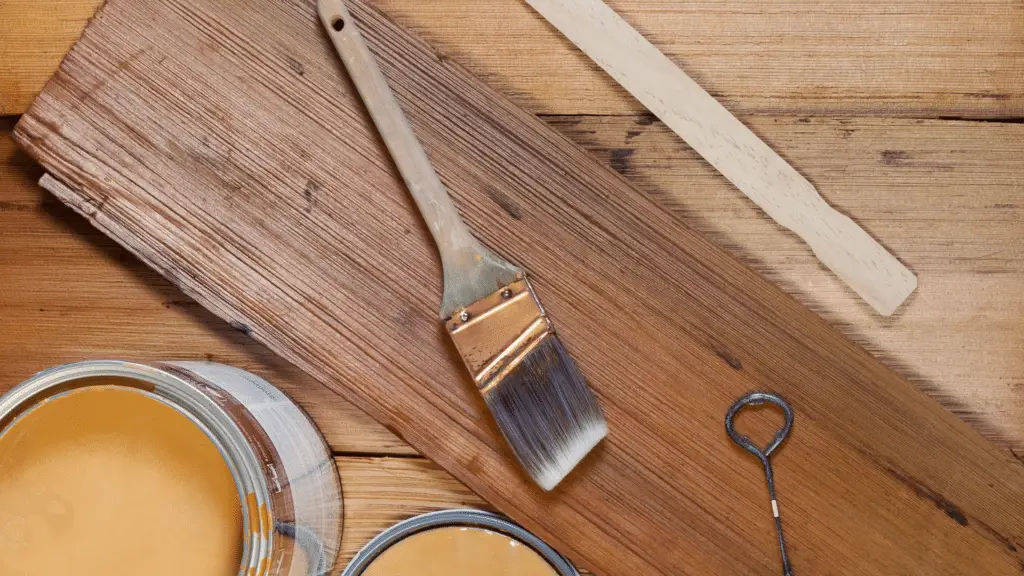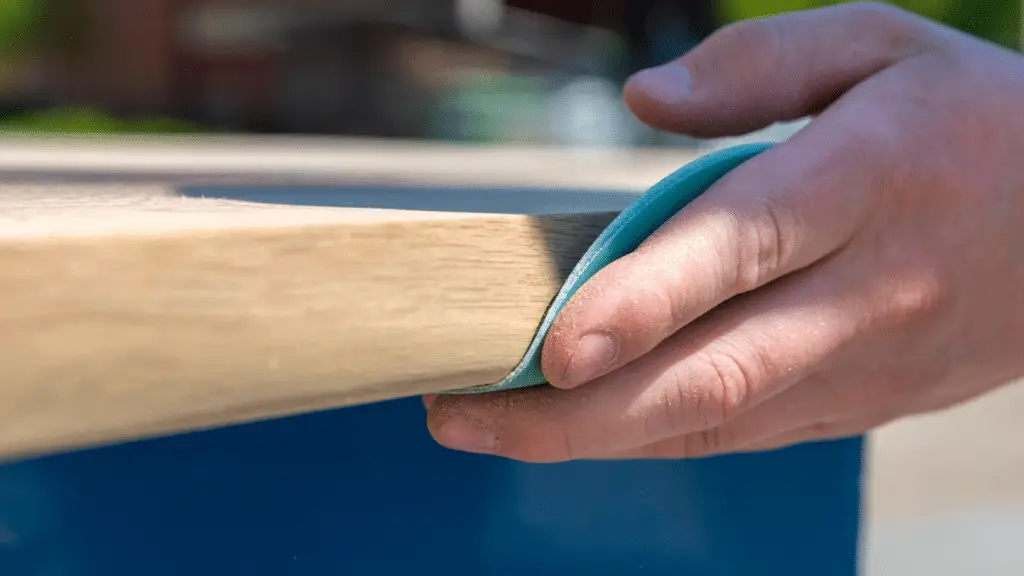If you are finishing a project of your own, or you are refurbishing an old piece of furniture, and you are not entirely happy with the results of the stain job, you may need to fix the stain job. Fortunately, fixing a bad wood stain job is possible, and we can guide you through the process to get your wood stain job looking good!
Fixing a bad wood stain job can be done by spot-fixing problem areas to lighten or darken the finish or remove tacky spots. Applying a second coat of stain fixes some problems, but for larger problems, the piece may need to be sanded down completely or chemically stripped before being re-stained.
Staining wood is not difficult, but sometimes things go wrong due to silly mistakes and sometimes due to the type of wood we are working with. Different densities in the wood may accept stain differently, or humidity and temperature have affected the absorption of the stain. Whatever the cause, it is possible to fix the stain job and salvage your project with a little extra effort.
Fixing A Bad Wood Stain Job
A bad wood stain job can make the difference between the finish on your project looking spectacular or amateurish. If you are dissatisfied with how the staining turned out, there is no need to relegate your project to the firewood pile just yet.

The method to fixing the stain job will depend on what has gone wrong with the initial job. Some problems can be fixed by addressing problem areas, while other issues may call for drastic measures. The drastic measures may require starting over from scratch.
Our guide will take you through the various ways of fixing a bad stain job to apply the most appropriate method to your project.
Evaluate Bad Wood Stain Job To Determine Corrective Steps
The first step to fixing a wood stain job that is not to your satisfaction is to pause and closely examine the problem.
This will determine your plan of attack to address the issue. If it is a new stain job, some aspects of the staining job can go wrong, which can be fixed by spot-fixing the affected areas.
Suppose you are not happy with the staining over the majority of the piece or restoring the finish on an old piece of furniture, more drastic. In that case, intensive repair steps are needed to get the finish you desire.
Spot Fixing A Bad Wood Stain Job
If you are working on a new woodworking project, several things can go wrong when applying the stain. Quick action can remedy the problem and limit the intensity of measures required to fix the stain job.
We have detailed some of the issues that can arise during the staining process and how to spot-fix these problem areas before applying your final finish.
The Wood Stain Has Not Dried Properly
If the air temperature is too hot, conditions are windy, or you stained your piece in the sun, the stain may not soak into the wood properly.

In these instances, the stain will not have the opportunity to soak completely into the wood, and it dries on the surface before you have the chance to wipe it off. This results in sticky, tacky areas on the surface of the wood. These spots will never dry out completely and will remain tacky.
This can affect the final finish that you intend to put on the wood. The only remedy is to address these sticky spots and remove them.
- Oil-based wood stain sticky spots. Dip the corner of a rag in mineral spirits and rub the tacky area until the sticky residue is removed. Use a clean sponge to wipe over the area to even out the wood stain.
- Water-based wood stain sticky spots. Moisten a portion of a rag with water and rub the cloth over the tacky spots on the wood’s surface. The water will dissolve the sticky spot, and you can then wipe it off with a clean sponge.
Try to rub only the sticky area of wood stain. If you rub too large an area, you may lighten the stain on the surrounding area. If this happens, you can apply more stain on the affected area but then wipe the excess off as quickly as possible to prevent this area from becoming too dark.
Lightening Dark Areas Of Wood Stain
If areas of your workpiece came out too dark after staining, you could lighten the stain in those areas by following this method.
Some wood stains require a specialized wood stain thinner to lighten the dark area, but you can use mineral spirits for this purpose in other cases. Make sure you use the correct stain thinner that your stain product recommends.
Dab a clean cloth with the stain thinner or mineral spirits and rub the cloth over the area that you want to lighten. Do not soak the cloth in the thinner, as it will spread to areas where you do not want to lighten the color.
Give the area 2-minutes to dry to evaluate if it has lightened sufficiently; if not, repeat the lightening process until you get the desired color in the dark area.
Darkening Areas Of Wood Stain
If certain areas of your stained piece turned out lighter than what you would like, then you should try the following process to darken those areas.
Dip a sponge in the same stain that you applied previously and wipe another coat onto the areas of the wood that appear too light. Wipe off the excess wood stain quickly with a clean rag or sponge.
Only apply the additional stain to the areas that are too light. Repeat the process until the light area has darkened to how you want it.
Allow the stain to dry completely, usually 24-hours, before applying your final finish.
Even Out Wood Stain With Gel Stain
Another approach you can use to even out the stain on the wood is to apply a coat of gel stain over the entire piece.

Gel stain works a little differently from other types of stain. It does not penetrate as deeply but rather works on the surface layers of the wood. The color can be built up with multiple layers of gel stain, which can even out light and dark areas of the previous stain job.
Gel stain is a good option to use on cheaper wood, such as pine, which is notorious for a blotchy finish when the stain is applied. Because gel stain does not penetrate deeply but dries as a layer on the surface, it prevents the frustrating blotchy finish on these types of wood.
Applying Another Stain Coat To Fix The Bad Wood Stain Job
If you are working on a new woodworking project and have applied a coat of wood stain to the project for the first time, but you are not satisfied with the result, there can be an easy fix.
Often, the first coat of stain will not look completely as good as you had hoped. Applying a second coat of stain will fix the problem and even out the stain in many cases. Applying a second coat of wood stain will darken the finish, but a slightly darker shade may be preferable to an uneven finish.
Always wait for the first coat of stain to completely dry before applying the second coat of wood stain. If there are tacky spots from the first coat, and you apply the second coat, these spots will not dry and remain sticky.
If the second coat of wood stain has not delivered the desired result, you have a couple of options. You can try and spot-fix the areas you are unhappy with by using the methods we have already detailed, or you can start over using one of the options detailed below.
Starting Over To Fix A Bad Wood Stain Job
There are two primary starting over methods you can use to repair a bad wood stain job. One method is appropriate for a new project on raw wood, while the other is generally used to restore or refinish old pieces of furniture.
Sanding Down To Fix A Bad Wood Stain Job By Starting Over
This is one of the drastic measures we spoke about earlier to fix a bad wood stain job. This method is the one to use if you are not happy with a large portion of the stain job and don’t think spot-fixing will do the trick. You can also use this method to restore older pieces, especially on lighter-colored stains.

This method will require some additional work and time to remove the old stain and try again to apply the wood stain to get the desired finish.
This process involves a lot of sanding, so a power sander such as an orbital sander, or a palm sander, will be very useful to speed up the process. However, you can complete the sanding by hand; it will just be more tiring and will
- Sand down with 80 to 150-grit sandpaper. Using low grit sandpaper will strip the upper layers of the wood where the stain has penetrated. Sand carefully to not go too deep with these grits and damage the project. Always sand with the wood grain to prevent placing deep scratches across the grain.
- Sand the wood with 400 and 800-grit sandpaper. Once the wood stain has been removed with the more aggressive grit sandpaper, switch to a higher grit such as a 400-grit to provide a smooth surface. If you need a smoother finish, go up to 800-grit and have another pass over the entire project, always sanding with the grain.
- Wipe the project off with a damp cloth to remove dust. Removing the sanding dust will give you a better, more even application of the wood stain. Allow the wood surface to dry thoroughly before applying any stain.
- Apply the wood stain. Apply your chosen wood stain carefully, ensuring to follow the instructions recommended by the stain manufacturer. Generally, the preferred method is to use a cloth or a sponge to apply the stain and a clean cloth to wipe off the excess. The amount of time to wait before wiping the excess off will vary from product to product.
Sanding the project down to remove the bad stain job will give you a clean canvas to re-apply the wood stain. Taking care during the sanding and always sanding with the wood grain will pay dividends with an even application of the wood stain.
Use Chemical Stripper To Remove A Bad Wood Stain Job And Start Over
A chemical stripper may be required to remove all the finish on a project, including the old, bad stain job, to prepare the piece for refinishing.
You can use chemical strippers on a new project, but the sanding method is usually sufficient on new projects, bypassing the need to use harsh chemicals.
You will need a few supplies to chemically strip the wood stain from your project.
- An appropriate wood stain stripper. Don’t use a paint stripper; the product your use must be specific for removing wood stain.
- A scraper. A metal scraper to remove the stain once the chemicals have done their job.
- Mineral spirits. For stubborn stain removal.
- Steel wool. Light steel wool is useful for stubborn spots.
- 220-grit sandpaper. This is to smooth off the wood before re-staining.
- PPE. Gloves, eye protection, and a respirator are requirements for working with many of these types of chemical products.
The process for using the chemical stripper is relatively easy. The best method is to follow the directions that came with the product, but the general steps are as follows.
- Apply the chemical stripper. Apply the stripper to all surfaces of the workpiece with a brush or sponge.
- Wait for the directed amount of time. The instructions for the product you use will inform you how long you need to wait for the chemicals in the product to lift the stain out of the wood. As the length of time progresses, you should see the chemicals lifting the stain from the wood.
- Scrape off the stripper and stain. Use the scraper to scrape off the stain and wood finish that the stripper has lifted off the wood.
- Apply a second treatment if necessary. Follow the product instructions for a second treatment if there is still a lot of stain left on the wood.
- Use steel wool dipped in mineral spirits to clean off stripper and stain residue. Use the mineral spirits with some steel wool to gently scrub away any residual stain and stripper residue.
- Sand down the workpiece. Use the 220-grit sandpaper to smooth off the entire piece to prepare it for re-staining. You can perform a secondary sanding with a higher grit for an even smoother finish. Remember to always sand with the wood’s grain for easier application of the new stain.
This completes removing the old, bad wood stain job and prepares your project to receive the new stain or finish you want to apply.
Covering Up a Bad Wood Stain Job
If you are looking for an easier fix and are prepared to adjust your expectations for the final finish and look of the project, you may opt to cover up the bad wood stain job.
There are two main ways to cover up the stain job, both of which will change the final finish of the project.
- Stain with a darker color. If the original stain was a lighter-colored stain, re-staining the workpiece a darker color will cover the original uneven stain. You still need to check for tacky spots where the stain has dried on the wood surface and address these before applying the darker color.
- Paint the project. This option will hide the imperfect stain job under a coat of paint, but you will also lose the wood’s intrinsic beauty showing through the finish. This option should only be chosen as a last resort, or if painting the wood fits in with other décor in your home.
Conclusion
A bad wood stain job can generally be remedied, but the intensity of the method to fix the problem will depend on the extent of the problem.
In most cases, minor adjustments to certain problem areas of the project are sufficient to get the desired finish.
Even f you need to resort to the more drastic measures of sanding down the entire project or using chemical strippers, the effort is worth it to have a final product that you can be proud of!
References
https://en.wikipedia.org/wiki/Wood_stain
https://www.thisoldhouse.com/woodworking/21015273/fix-a-wood-stain-mistake
https://www.thesawguy.com/how-to-fix-a-bad-stain-job/
https://repairdaily.com/how-to-fix-a-bad-stain-job/

